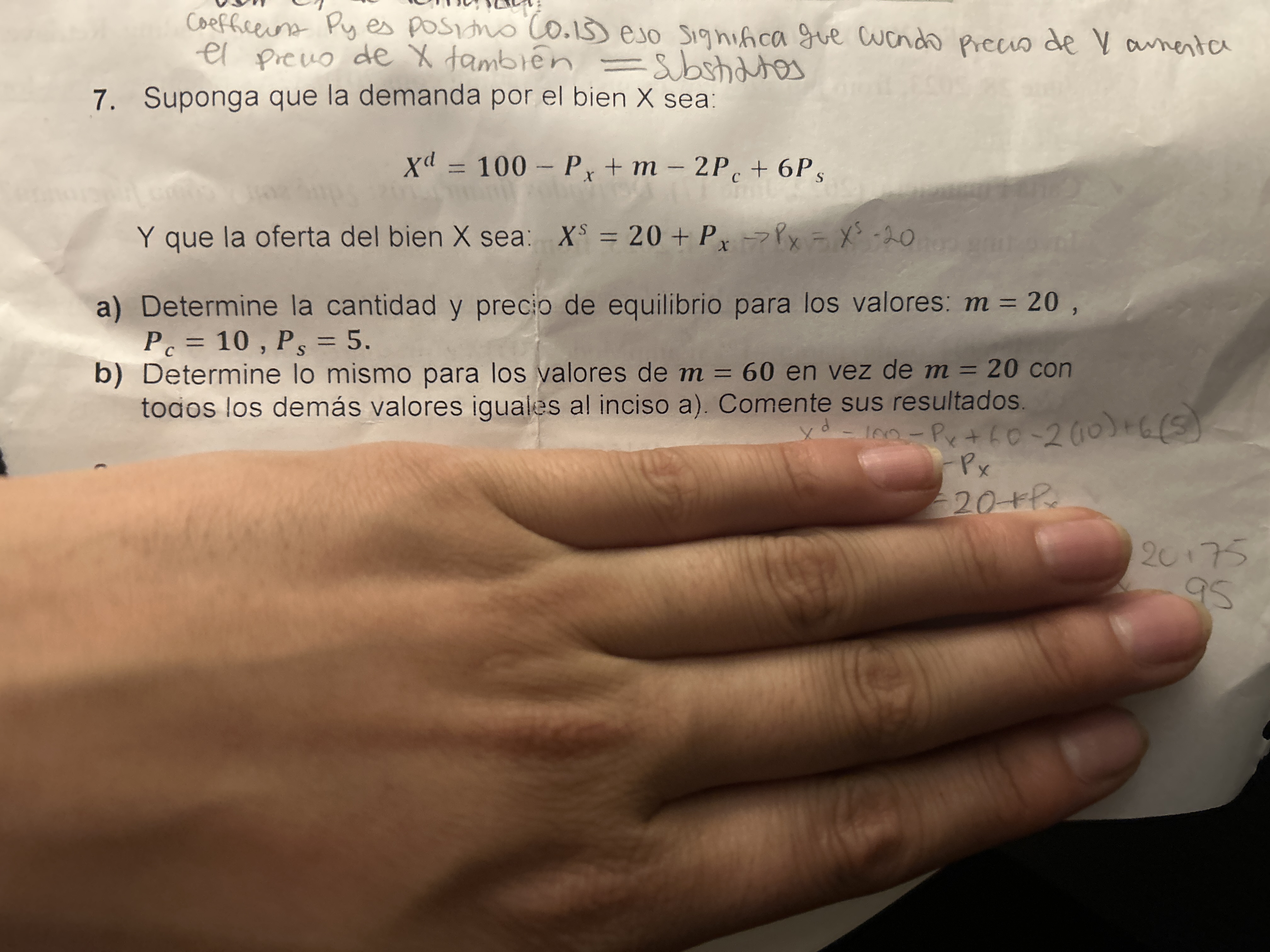Suponga que la demanda por el bien X sea: Xd = 100 - Px + m - 2Pc + 6Ps y que la oferta del bien X sea: Xs = 20 + Px. Determine la cantidad y precio de equilibrio para los valores:... Suponga que la demanda por el bien X sea: Xd = 100 - Px + m - 2Pc + 6Ps y que la oferta del bien X sea: Xs = 20 + Px. Determine la cantidad y precio de equilibrio para los valores: a) m = 20, Pc = 10, Ps = 5. b) Determine lo mismo para los valores de m = 60 en vez de m = 20 con todos los demás valores iguales al inciso a). Comente sus resultados.

Understand the Problem
El problema presenta ecuaciones de demanda y oferta para un bien X. Primero, debes determinar la cantidad y el precio de equilibrio cuando m = 20, Pc = 10 y Ps = 5. Luego, se pide hacer lo mismo cuando m = 60, manteniendo los demás valores iguales, y comentar los resultados.
Answer
a) $P_x = 55$, $X = 75$ b) $P_x = 75$, $X = 95$
Answer for screen readers
a) $P_x = 55$, $X = 75$ b) $P_x = 75$, $X = 95$ Cuando el valor de $m$ (ingreso del consumidor) aumenta, tanto el precio como la cantidad de equilibrio del bien X aumentan.
Steps to Solve
-
Part a: Calculate $X^d$ Substitute the given values into the demand equation: $X^d = 100 - P_x + m - 2P_c + 6P_s$ with $m = 20$, $P_c = 10$, and $P_s = 5$. $X^d = 100 - P_x + 20 - 2(10) + 6(5)$ $X^d = 100 - P_x + 20 - 20 + 30$ $X^d = 130 - P_x$
-
Part a: Equate demand and supply to find equilibrium Set $X^d = X^s$ to find the equilibrium. We have $X^d = 130 - P_x$ and $X^s = 20 + P_x$. $130 - P_x = 20 + P_x$ $130 - 20 = P_x + P_x$ $110 = 2P_x$ $P_x = 55$
-
Part a: Calculate equilibrium quantity Substitute the equilibrium price $P_x = 55$ into either the demand or supply equation. Using the supply equation: $X^s = 20 + P_x = 20 + 55 = 75$ So, $X = 75$
-
Part b: Calculate $X^d$ with new $m$ Substitute the new value of $m = 60$ into the demand equation, keeping $P_c = 10$ and $P_s = 5$: $X^d = 100 - P_x + 60 - 2(10) + 6(5)$ $X^d = 100 - P_x + 60 - 20 + 30$ $X^d = 170 - P_x$
-
Part b: Equate demand and supply to find equilibrium with new $m$ Set $X^d = X^s$ to find the new equilibrium. Now we have $X^d = 170 - P_x$ and $X^s = 20 + P_x$. $170 - P_x = 20 + P_x$ $170 - 20 = P_x + P_x$ $150 = 2P_x$ $P_x = 75$
-
Part b: Calculate equilibrium quantity with new $m$ Substitute the new equilibrium price $P_x = 75$ into either the demand or supply equation. Using the supply equation: $X^s = 20 + P_x = 20 + 75 = 95$ So, $X = 95$
-
Part b: Comment on the results When the value of $m$ increases from 20 to 60, the equilibrium price increases from 55 to 75, and the equilibrium quantity increases from 75 to 95. This indicates that as $m$ increases, both the price and quantity of good X increase
a) $P_x = 55$, $X = 75$ b) $P_x = 75$, $X = 95$ Cuando el valor de $m$ (ingreso del consumidor) aumenta, tanto el precio como la cantidad de equilibrio del bien X aumentan.
More Information
The parameter $m$ often represents income. Here, as income increases, both the equilibrium price and quantity increase, suggesting that good X is a normal good.
Tips
A common mistake is incorrectly substituting the values into the demand equation or making algebraic errors when solving for the equilibrium price and quantity. Also, using the incorrect equation is another common mistake (demand instead of supply). Be careful with the signs and operations.
AI-generated content may contain errors. Please verify critical information